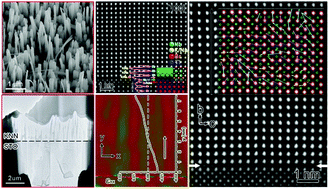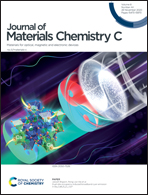Atomic scale study of the oxygen annealing effect on piezoelectricity enhancement of (K,Na)NbO3 nanorods†
Abstract
With the increasing requirement of developing non-toxic piezoelectric materials, an alkaline niobate-based perovskite solid (K,Na)NbO3 (KNN) has been intensively studied. Promising piezoelectric properties are reported, which are mostly achieved by adding other elements, or simply varying the K/Na ratio. It is found that KNN nanorods grown on conductive Nb-doped SrTiO3 (STO) substrates show enhanced piezoelectric properties after annealing at 800 °C for 12 h [Y. He, Z. Wang, W. Jin, X. Hu, L. Li, Y. Gao, X. Zhang, H. Gu and X. Wang, Appl. Phys. Lett., 2017, 110, 212904]. However, the underlying mechanism for property enhancement at the atomic scale is not clearly revealed. In this study, comprehensive transmission electron microscopy techniques are utilized focusing on the atomic scale study of the interfacial composition, structures, strain, dipolar displacement vectors and their variations along the interface normal of the as-grown and annealed KNN nanorods. The results indicate phase transformation during annealing, and a larger spontaneous polarization within each unit cell of the annealed KNN nanorods, which lead to an overall enhancement of the piezoelectric properties. These results would be very beneficial for advanced nanogenerators and sensors with enhanced piezoelectric properties.



 Please wait while we load your content...
Please wait while we load your content...